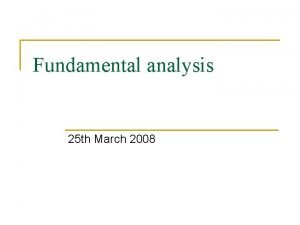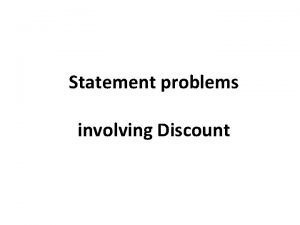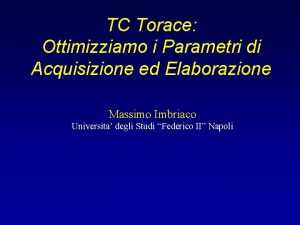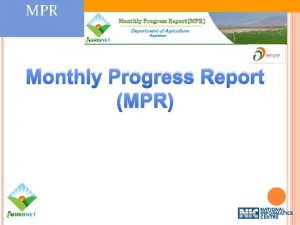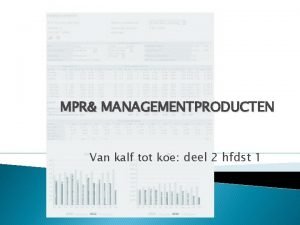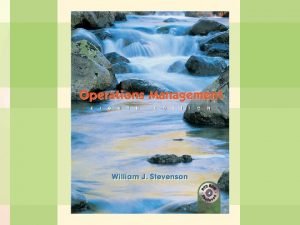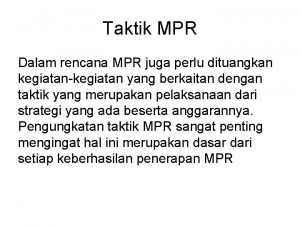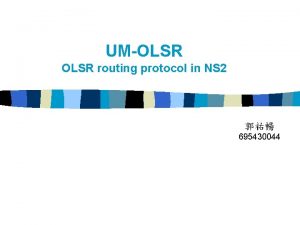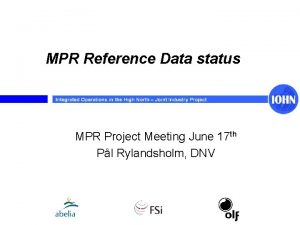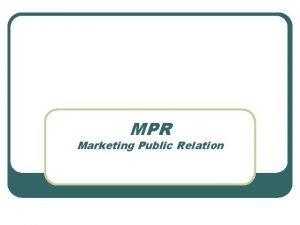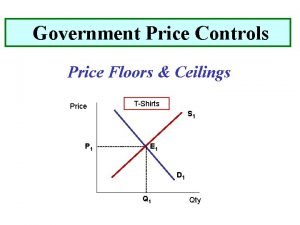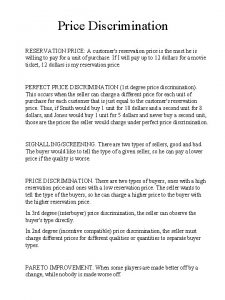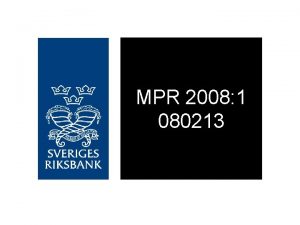MPR Price Risk Presentation March 27 2008 MPR



























- Slides: 27

MPR Price Risk Presentation March 27, 2008 MPR Workshop

Agenda • Frame the questions • Fuel Price Risk • Forecasting Fixed Forward Fuel Price • Portfolio Analysis (CAPM)

The MPR Proxy Plant • Best estimate of market price for long-term fixed price electricity – Independent CCGT with IOU contract – All-in $/MWh price needed to attract new investment • A market benchmark – Does not include costs or benefits specific to renewable generation • A proxy for a market that does not exist

Key Questions • What are the terms of the contract between the IPP and the IOU? – All-in fixed price with TOU shape – Dispatched by IPP • How would IPP procure fuel? – Fixed forward or rolling forward contracts • Is MPR Proxy exposed to fuel price risk?

Key Questions • Available Fuel Price Data – Near-term: NYMEX – Long-term: Fundamental Forecast • How to use NYMEX and Forecasts to estimate fixed forward contract price?

Agenda • Fuel Price Risk • Forecasting Fixed Forward Fuel Price • Portfolio Analysis (CAPM)

Is MPR Proxy exposed to fuel price risk? • Four procurement options 1. Buy spot energy at $P/MWh: Total cost = PQ 2. Buy forward contract at $F/MWh: Total cost = FQ 3. Build a reliable power plant and buy spot gas: Total cost = CN + Fixed cost, where C = fuel cost per MMBTU, and N = natural gas requirement to produce Q 4. Build a reliable power plant and buy forward gas at $G/MMBTU: Total cost = GN + Fixed cost

No Cost Risk for MPR Proxy • Options with Price Risk 1. Spot purchase – has cost risk due to electricity price risk 2. Forward contract – no cost risk, zero price or quantity variation 3. Fossil Plant – has cost risk due to natural gas price risk 4. Fossil Plant with fixed price fuel contract – has no cost risk: zero price or quantity variation

Additional Hedge Cost? • Assume MPR has procured fixed price forward contract for fuel • Are there additional costs to eliminate price risk? No – Price Risk Premium? • embedded in forward contract

Price Risk Premium • Risk premium = Fixed price – Expected spot price • Why does it exist? Mainly market sentiment – Large positive risk premium, when buyers are scared of potential price spikes, allowing sellers to demand more dollars for absorbing the price risk – Negative risk premium, when the market expects surplus capacity and sellers need steady cash flow to pay debt obligation • Is risk premium always positive or negative? No • Is risk premium a constant number? No

Agenda • Fuel Price Risk • Forecasting Fixed Forward Fuel Price • Portfolio Analysis (CAPM)

Forward Price Tends to be Higher Than Fundamental Forecast Source: Bolinger, Mark, Ryan Wiser and William Golove (2002) “Quantifying the value that Wind Power Provides as a Hedge Against Volatile Natural Gas Prices, ” LBNL-50484, Figure 4.

What is NYMEX – Fundamentals Relationship? • Forwards appear to be higher than Fundamentals – Price Risk Premium? – Forecast Bias? • Use full 12 years of NYMEX data? – Thinly traded, but it is still a trade • How to project beyond NYMEX trading period?

MPR Gas Price Methods 2004 MPR Market Long-Term NYMEX Fundamental + Difference Regression NYMEX Trend

Agenda • Fuel Price Risk • Forecasting Fixed Forward Fuel Price • Portfolio Analysis (CAPM)

Cost Risk With Variable Generation • Options with Price Risk 2. Forward contract – no cost risk, zero price or quantity variation 3. Fossil Plant – has cost risk due to natural gas price risk 4. Fossil Plant with fixed price fuel contract – has no cost risk: zero price or quantity variation 5. Renewable Generation with variable output – • has no fuel price risk, but variable quantity What if Q is variable?

Random output profile (Source: Mansour, Y. The Future is Now: Power Industry Challenges in California, IEEE San Francisco Annual Banquet, October 4, 2005, Folsom: CAISO)

Cost Variance of Intermittent Energy • The contract has a fixed price W. • The expected output is the desired quantity, say Q MWh – The actual wind output is q MWh • Total procurement cost = QW + (q – Q)P = Expected output at fixed price + Output deviation transacted at spot price • Thus a wind contract can have both price and quantity risks because of (q – Q)P.

Capital Asset Pricing Model • Return on asset required by investors is determined by performance of that asset compared to the market as a whole (Beta) • Used to define efficient frontier (next slide) – The model is estimated using exchange traded market data on asset return. – Makes no statement regarding financing (leverage) – Useful organizing principle with strong set of assumptions

Investor Efficient Frontier Return Stocks/Bonds Inefficient Portfolio Money Market Risk • Shows tradeoff between risk and return • Does not determine single optimal portfolio • Depends on risk tolerance of individual investor

What risks does a utility face? • Price Risk (e. g. , spot price volatility, fuel cost volatility, emissions cost risk) • Demand Risk (e. g. , uncertain load) • Supply Risk (e. g. , hydro, intermittent resources) • Performance Risk (e. g. , forced outage, DSM response) • Regulatory risk (e. g. , prudency review, GHG/RPS targets, emissions controls) A portfolio analysis summarizes these risks into efficient frontiers that aid decision making under uncertainty.

Cost Variance ($Billion) Efficient Frontiers Based on Spot and Forward Purchases Expected Cost ($Million) Source: Woo, C. K. , I. Horowitz, B. Horii and R. Karimov (2004) “The Efficient Frontier for Spot and Forward Purchases: An Application to Electricity, ” Journal of the Operational Research Society, 55, 1130 -1136, Figure 1.

Investor and Utility Efficient Frontier are Different • Investor efficient frontier (CAPM) derived for asset return in active market with few restrictions and strong assumptions • Utility assets not actively traded • Utility faces non-price risks • Utility portfolio subject to constraints

Extra Slides

Carbon Price Risk Source: Barbose, Galen, Ryan Wiser, Amol Phadke and Charles Goldman (2008) “Reading the Tea Leaves: How Utilities in the West are Managing Carbon Regulatory Risk in their Resource Plans, ” LBNL-44 E, Figure 7.

Portfolio Analysis for Utilities • Problem: To choose a portfolio of renewable and conventional resources to minimize the portfolio’s cost variance, subject to the following constraints: a. The utility’s cost expectation; b. The utility’s load obligations; c. The RPS target faced by the utility; d. The GHG emissions restriction faced by the utility; e. DSM target; f. RAR target. • Solution: A point on the efficient frontier that portrays cost expectation on the x-axis and minimum cost variance on the y-axis. By varying the cost expectation values in (a), one can find more points to form an efficient frontier, one that is conditional on the values in (b) – (e). • Can there be multiple frontiers? Yes. Altering the values of (b) - (e) will give a different efficient frontier that policymakers may use to evaluate their effect on cost expectation and cost risk. Q. What can one learn from the set of frontiers? A. One can learn: (1) the tradeoff between cost expectation and cost risk, and (2) how the tradeoff can be affected by such factors as the utility’s load forecast and the regulator’s actions on RPS and GHG.

Price risk premium • Output price premium = (electric forward price - expected spot price) is likely positive based on empirical evidence. • Fuel price premium = (Natural gas futures price – expected spot price) can be positive or negative. • Can risk premium be measured? – Yes, if forward/futures price data are available • Is risk premium constant? – No, it depends on market sentiment.
 Ito ay kilala rin sa katawagang bilang maximum price policy
Ito ay kilala rin sa katawagang bilang maximum price policy March march dabrowski
March march dabrowski March 7 2008
March 7 2008 25 march 2008
25 march 2008 2008 2008
2008 2008 Market risk assessment
Market risk assessment Pagbabago ng presyo
Pagbabago ng presyo Marked price-selling price=
Marked price-selling price= Installment payment system meaning
Installment payment system meaning Difference between reactive sourcing and strategic sourcing
Difference between reactive sourcing and strategic sourcing Price discovery and price determination
Price discovery and price determination Voxel isotropico e anisotropico
Voxel isotropico e anisotropico Perbedaan cpr dan mpr
Perbedaan cpr dan mpr Monthly process
Monthly process Mpr uitslag
Mpr uitslag Mpr melkcontrole
Mpr melkcontrole Mpr jaaroverzicht
Mpr jaaroverzicht Mpr erp
Mpr erp Mpr it
Mpr it Taktik mpr
Taktik mpr Mpr
Mpr Taktik mpr
Taktik mpr Ricostruzione mpr
Ricostruzione mpr Pengertian public relation
Pengertian public relation Visi misi mpr
Visi misi mpr Pr influencer marketing
Pr influencer marketing Mpr project management
Mpr project management Mpr marketing
Mpr marketing



